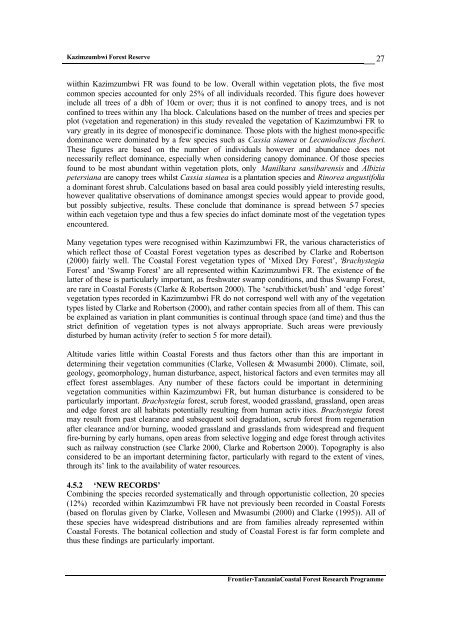Frontier Tanzania Environmental Research REPORT 110 ...
Frontier Tanzania Environmental Research REPORT 110 ...
Frontier Tanzania Environmental Research REPORT 110 ...
Create successful ePaper yourself
Turn your PDF publications into a flip-book with our unique Google optimized e-Paper software.
Kazimzumbwi Forest Reserve<br />
27<br />
wiithin Kazimzumbwi FR was found to be low. Overall within vegetation plots, the five most<br />
common species accounted for only 25% of all individuals recorded. This figure does however<br />
include all trees of a dbh of 10cm or over; thus it is not confined to canopy trees, and is not<br />
confined to trees within any 1ha block. Calculations based on the number of trees and species per<br />
plot (vegetation and regeneration) in this study revealed the vegetation of Kazimzumbwi FR to<br />
vary greatly in its degree of monospecif ic dominance. Those plots with the highest mono-specific<br />
dominance were dominated by a few species such as Cassia siamea or Lecaniodiscus fischeri.<br />
These figures are based on the number of individuals however and abundance does not<br />
necessarily reflect dominance, especially when considering canopy dominance. Of those species<br />
found to be most abundant within vegetation plots, only Manilkara sansibarensis and Albizia<br />
petersiana are canopy trees whilst Cassia siamea is a plantation species and Rinorea angustifolia<br />
a dominant forest shrub. Calculations based on basal area could possibly yield interesting results,<br />
however qualitative observations of dominance amongst species would appear to provide good,<br />
but possibly subjective, results. These conclude that dominance is spread between 5-7 species<br />
within each vegetaion type and thus a few species do infact dominate most of the vegetation types<br />
encountered.<br />
Many vegetation types were recognised within Kazimzumbwi FR, the various characteristics of<br />
which reflect those of Coastal Forest vegetation types as described by Clarke and Robertson<br />
(2000) fairly well. The Coastal Forest vegetation types of ‘Mixed Dry Forest’, ‘Brachystegia<br />
Forest’ and ‘Swamp Forest’ are all represented within Kazimzumbwi FR. The existence of the<br />
latter of these is particularly important, as freshwater swamp conditions, and thus Swamp Forest,<br />
are rare in Coastal Forests (Clarke & Robertson 2000). The ‘scrub/thicket/bush’ and ‘edge forest’<br />
vegetation types recorded in Kazimzumbwi FR do not correspond well with any of the vegetation<br />
types listed by Clarke and Robertson (2000), and rather contain species from all of them. This can<br />
be explained as variation in plant communities is continual through space (and time) and thus the<br />
strict definition of vegetation types is not always appropriate. Such areas were previously<br />
disturbed by human activity (refer to section 5 for more detail).<br />
Altitude varies little within Coastal Forests and thus factors other than this are important in<br />
determining their vegetation communities (Clarke, Vollesen & Mwasumbi 2000). Climate, soil,<br />
geology, geomorphology, human disturbance, aspect, historical factors and even termites may all<br />
effect forest assemblages. Any number of these factors could be important in determining<br />
vegetation communities within Kazimzumbwi FR, but human disturbance is considered to be<br />
particularly important. Brachystegia forest, scrub forest, wooded grassland, grassland, open areas<br />
and edge forest are all habitats potentially resulting from human activ ities. Brachystegia forest<br />
may result from past clearance and subsequent soil degradation, scrub forest from regeneration<br />
after clearance and/or burning, wooded grassland and grasslands from widespread and frequent<br />
fire-burning by early humans, open areas from selective logging and edge forest through activites<br />
such as railway construction (see Clarke 2000, Clarke and Robertson 2000). Topography is also<br />
considered to be an important determining factor, particularly with regard to the extent of vines,<br />
through its’ link to the availability of water resources.<br />
4.5.2 ‘NEW RECORDS’<br />
Combining the species recorded systematically and through opportunistic collection, 20 species<br />
(12%) recorded within Kazimzumbwi FR have not previously been recorded in Coastal Forests<br />
(based on florulas given by Clarke, Vollesen and Mwasumbi (2000) and Clarke (1995)). All of<br />
these species have widespread distributions and are from families already represented within<br />
Coastal Forests. The botanical collection and study of Coastal Forest is far form complete and<br />
thus these findings are particularly important.<br />
<strong>Frontier</strong>-<strong>Tanzania</strong>Coastal Forest <strong>Research</strong> Programme

















